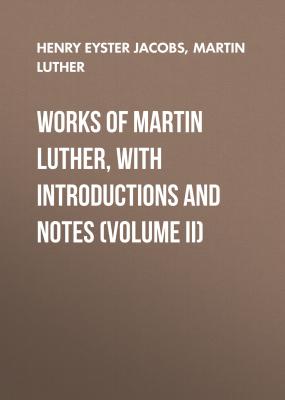Works of Martin Luther, with Introductions and Notes (Volume II). Martin Luther
Чтение книги онлайн.
Читать онлайн книгу Works of Martin Luther, with Introductions and Notes (Volume II) - Martin Luther страница 30
 claimed that the government of the clergy and the administration of Church property must be entirely in the hands of the Church authorities, and that no lay rulers might either make or enforce laws which in any way affected the Church. See Lea,
claimed that the government of the clergy and the administration of Church property must be entirely in the hands of the Church authorities, and that no lay rulers might either make or enforce laws which in any way affected the Church. See Lea, 122
It was the contention of the Church authorities that priests charged with infraction of the laws of the state should first be tried in the ecclesiastical courts. If found guilty, they were degraded from the priesthood and handed over to the state authorities for punishment. Formula for degradation in the canon law, C. 2 in VI,
123
The interdict is the prohibition of the administration of the sacraments and of the other rites of the Church within the territory upon which the interdict is laid (
124
The statement of which Luther here complains is found in the Decretum of Gratian,
125
Gregory the Great, pope 590-604. The passage is found in Migne, LXXVI, 203; LXXVII, 34.
126
Antichrist, the incarnation of all that is hostile to Christ and His Kingdom. His appearance is prophesied in 2 Thess. 2:3-10 (the "man of sin, sitting in the temple of God"); 1 John 2:18, 22; 4:3, and Rev. 13. In the early Church the Fathers sometimes thought the prophecies fulfilled in the person of some especially pestilent heretic. Wyclif applied the term to the pope,—"the pope would seem to be not the vicar of Christ, but the vicar of Antichrist" (see Loos,
127
According to academic usage, the holder of a Master's degree was authorised to expound the subject named in the degree.
128
The doctrine of papal infallibility was never officially sanctioned in the Middle Ages, but the claim of infallibility was repeatedly made by the champions of the more extreme view of papal power, e. g., Augustinus Triumphus (died 1328) in his
129
Most recently in Prierias's
130
Luther had discussed the whole subject of the power of the keys in a Latin treatise,
131
Pp. 66 ff.
132
Another contention of Prierias. In 1518 (Nov. 25th) Luther had appealed his cause from the decision of the pope, which he foresaw would be adverse, to the decision of a council to be held at some future time. In the
133
i. e., A mere gathering of people.
134
The Council of Nicæa, the first of the great councils of the Church, assembled in 325 for the settlement of the Arian controversy. Luther's statement that it was called by the Emperor Constantine, and that its decisions did not derive their validity from any papal confirmation, is historically correct. On Luther's statements about this council, see _Schäffer,
135
Luther is here referring to the earlier so-called "ecumenical" councils.
136
i. e., A council which will not be subject to the pope. Cf.
137
i. e., They belong to the "spiritual estate"; see above, p. 69.
138
139
The papal crown dates from the XI Century; the triple crown, or tiara, from the beginning of the XIV. It was intended to signify that very superiority of the pope to the rulers of this world, of which Luther here complains. See
140
A statement made by Augustinus Triumphus. See above, p. 73, note 5; and below, p. 246.
141
The Cardinal della Rovere, afterwards Pope Julius II, held at one time the archbishopric of Avignon, the bishoprics of Bologna, Lausanne, Coutances, Viviers, Mende, Ostia and Velletri, and the abbacies of Nonantola and Grottaferrata. This is but one illustration of the scandalous pluralism practised by the cardinals. Cf. Lea, in
142
The complaint that the cardinals were provided with incomes by appointment to German benefices goes back to the Council of Constance (1415). C. Benrath, p. 87, note 17.
143
The creation of new cardinals was a lucrative proceeding for the popes. On July 31, 1517, Leo X created thirty-one cardinals, and is said to have received from the new appointees about 300,000 ducats. Needless to say, the cardinals expected to make up the fees out of the income of their livings. See
144
The famous Benedictine monastery just outside the city of Bamberg.
145
The proposal made at Constance (see above, p. 82, note 2) was more generous. It suggested a salary of three to four thousand gulden.
146
As early as the XIV Century both England and France had enacted laws prohibiting the very practices of which Luther